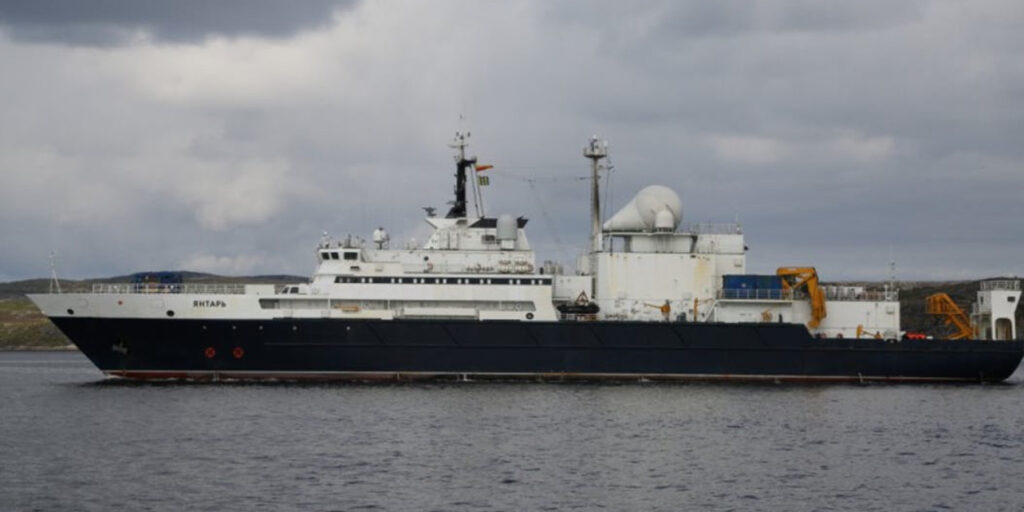The UK Defence Committee recently addressed growing concerns about undersea cable security in the Baltic Sea and the activities of the Russian spy ship Yantar, which was spotted in UK waters. The session highlighted the strategic vulnerabilities of undersea infrastructure, particularly in light of recent incidents involving damage to critical cables across the North Atlantic, North Sea, and Baltic regions.
Defence Secretary John Healey emphasized the importance of safeguarding undersea assets, stating: “Clearly, there is a recognition in recent months, not least because we have seen damage to essential undersea cables in different parts of the north Atlantic, the North Sea, and the Baltic, that this is an area that requires attention.” Healey assured the Committee that the UK closely monitored Yantar during its activities: “We tracked them every mile of their circumvention and made sure that they knew we were watching.”
Lieutenant General Sir Rob Magowan, Deputy Chief of the Defence Staff, elaborated on the broader strategic threats, categorizing them into four key areas: NATO obligations, global responsibilities, homeland defense, and hybrid “grey zone” threats like cyber-attacks and infrastructure sabotage.
Healey further detailed the immediate response measures being implemented to counter these threats, including incorporating undersea cable security into the newly established UK-German defense agreement. “Undersea cables are a shared concern,” he said, emphasizing the importance of bilateral and NATO collaboration in addressing these risks. He also mentioned the ongoing Strategic Defence Review, which is already influencing actions and agreements to bolster the UK’s readiness against emerging threats.
The Yantar: A Strategic Concern for Undersea Security
The Yantar, a Russian Project 22010-class intelligence vessel, is operated by the Russian Navy and equipped with advanced capabilities for deep-sea operations. Acting as a mothership for Rus-class and Konsul-class mini-submarines, it can reach depths of up to 6,000 meters (around 20,000 feet), enabling potential interaction with critical undersea infrastructure such as telecommunications cables.
Although officially designated as an “oceanic research complex” by Alexei Burilichev, head of Russia’s deepwater research department, Yantar’s activities have repeatedly drawn international scrutiny. The vessel has been observed near sensitive undersea telecommunications routes, raising concerns about its potential to disrupt critical infrastructure.
The U.S. Navy has expressed concerns about Yantar’s ability to sever submarine cables, suspecting it may serve purposes beyond scientific exploration. Its activities have also sparked similar fears among NATO members, as the ship has frequently been reported near transatlantic communication cables.
Yantar’s Activities and International Scrutiny
Since its deployment, Yantar has been linked to strategic missions in several global hotspots. In 2015, it was sighted off Guantánamo Bay, Cuba, and later in Norwegian waters. It has also appeared near Greenland, Israel, Cyprus, and Brazil—regions that align with sensitive undersea cable networks or military recovery operations. Notably, in 2017, Yantar assisted in retrieving equipment from crashed Russian aircraft in the Mediterranean and contributed to the search for the missing Argentine submarine ARA San Juan.
More recently, Yantar’s movements have been documented near Ireland and within the English Channel, often in close proximity to submarine cables. In 2023, the Norwegian Coast Guard reported an incident in which Yantar shadowed the research vessel RV Kronprins Haakon for over 16 hours, an act described as harassment, though it adhered to international maritime law.
With a displacement of 5,736 tonnes, a length of 107.8 meters, and a range of 8,000 nautical miles, Yantar is designed for extended operations in remote areas. Its endurance of 60 days and advanced propulsion systems, including azipods and a helipad, further enhance its operational flexibility.
As the UK strengthens its defenses against undersea threats, the activities of vessels like Yantar underscore the growing importance of securing critical undersea infrastructure in an increasingly complex global security landscape.


